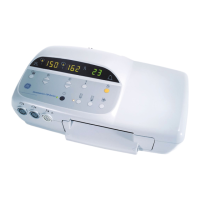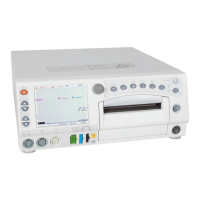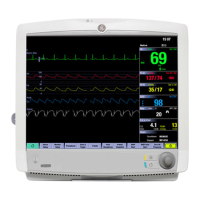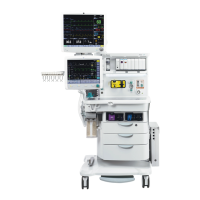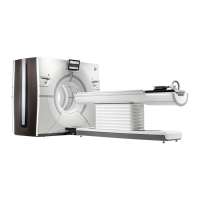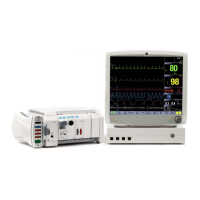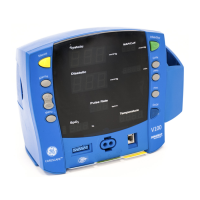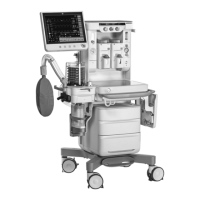Revision B 120 Series Maternal/Fetal Monitor 4-65
2015590-001
Theory of Operation: MECG Board
Leads Off Detection
The leads off detection relies on the equal DC biasing of the two patient input leads,
along with canceling effects of the right leg drive to common mode signals.
Resistors R17, R18, R20, and R21 apply a small DC common mode voltage to the
input leads. Under normal operating conditions, the right leg drive generates an
opposite potential that cancels out the effects of this voltage. However, when one of
the two input leads are not connected to the patient, a difference voltage across the
input leads is generated which equals the voltage drop across R21 or R20 through
the series combination of R17 and R18. This difference voltage is amplified using
the buffer stages from instrumentation amplifier U7 and a difference amplifier
consisting of op-amp U10, resistors R43, R46–R48, and capacitors C24 and C26.
This difference amplifier provides an additional gain of 1.8 over the gain of ten
supplied by the U7 buffer section. Capacitors C24 and C26 role off the response of
the amplifier to 3 Hz to prevent noise or large signals from affecting the operation of
the detection circuitry. The single-ended output from U7, which is also a difference
amplifier, is not used due to the baseline feedback connected to pin 10 which tries to
restore U7’s output to 0 V. If both leads are disconnected, the method of detection
relies on the right leg drive providing a saturated output to the patient. The right leg
drive, past limiting resistor R14 is buffered for detection by a unity gain non-
inverting amplifier from one section of op-amp U10. If the right leg drive itself is
the disconnected lead, it will also provide a saturated output trying to cancel the
common mode input voltage. The actual leads off detection is done by a pair of
comparators from two stages of op-amp U12. One comparator provides a positive
output when its input exceeds a positive threshold derived from the voltage division
of the +10 V reference across R73 and R75. The other provides a positive output
when its input drops below a negative threshold set by the voltage division of the –
10 V reference across R79 and R82. Diodes D25–D28 combine the outputs of the
difference amplifier and the right leg buffer as well as separating the negative and
positive excursions of these outputs for connection to the inputs of the two
comparators. D25 and D26 connect the outputs of the difference amplifier and the
right leg buffer when either goes positive to the positive threshold comparator. D27
and D28 connect these outputs to the negative threshold comparator when either
goes negative. When either output exceeds the threshold of one of the two
comparators, that comparator will toggle positive. Both outputs from the
comparators are ORed by diodes D29 and D30 that turn on transistor Q2. Q2
provides a level conversion from the 15 V outputs of the comparators to a +5 V logic
level. The output of Q2 connects to control circuitry on the FEGG/UA Board.
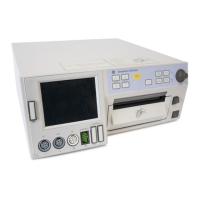
